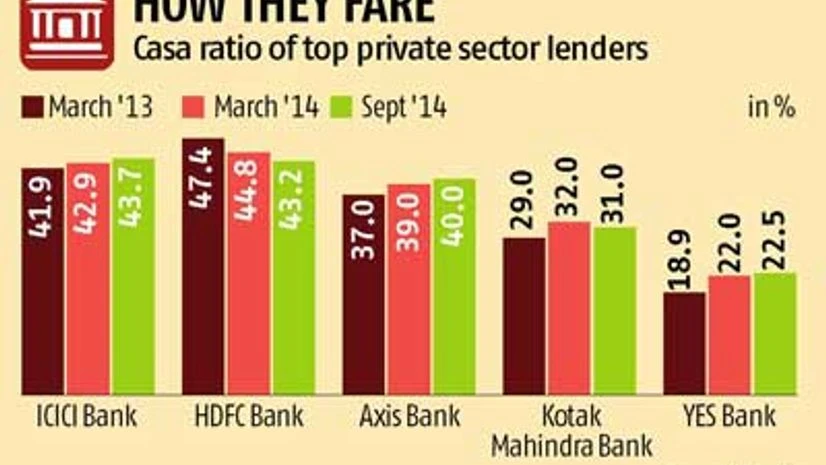When most private sector banks have seen the share of low-cost current account and savings account (Casa) deposits grow in their deposits pool, HDFC Bank, the country’s second largest private sector lender, has witnessed a fall in the share of Casa in the same period.
At the end of March 2013, Casa ratio in total deposits was at 47.4 per cent, which in the next six months slipped to 45 per cent (September 2013). At the end of March 2014, the ratio declined marginally to 44.8 per cent. It dipped to 43.2 per cent in quarter ended September 2014.
HDFC Bank attributes the fall in the share of low-cost deposits mainly to the increase in fixed-term deposits and FCNR(B) deposits that grew at a faster rate.
Sashi Jagdishan, chief financial officer, HDFC Bank, said, “The interest rate for fixed deposits have continued to remain elevated in the range of 8.5-9.5 per cent for the last two-three years, whereas savings bank rates have continued to be 4 per cent for majority of the banking system. Therefore, whenever there is a high gap between the two rates invariably there will be migration of funds from savings accounts to FDs.”
The lender had managed to garner $3.4 billion FCNR(B) deposits in the special window that RBI had allowed between September and November last year. However, analysts expressed doubts if the lender would be able to maintain the highest Casa ratio in the industry in the coming quarters. “The bank had continued to enjoy Casa ratio of close to 50 per cent during 2010-12 but it will be difficult to go back to that level now as the total size of the deposits have grown and competition has also increased,” said an analyst with a foreign brokerage house.
The quarterly growth rate of the profits for the bank had also slipped from the 25-30 per cent growth to near 20 per cent in the first two quarters of this year on the back of the slowing economy. After the June-ended quarter in 1998, the bank has managed to grow its net profit above 25 per cent till the end of December 2013.
Analysts believe that one way that the bank can see a substantial improvement in Casa ratio is if the bank manages to grow their current account (CA) component as the economy picks up. "In March 2013, the CA component of the bank was at 18 per cent, which has now slipped to 15 per cent at the end of the second quarter of this financial year," added the analyst.
Another reason analysts attribute the decline in the Casa ratio is to the slowdown in the corporate segment; the current account share of HDFC Bank has specifically suffered as the lender is a banker to major exchanges and corporates, say industry observers. However, the bank is unfazed by the change in the ratio. “Casa is an important tool but one also needs to look at the core margins of the bank which has remained stable in a range of 4.2 to 4.5 per cent for some time now,” added Jagdishan.
HDFC Bank’s peers in the same period have been improving their Casa ratio. At the end of the September quarter, ICICI Bank has the highest share of Casa ratio in the industry. At the end of the March quarter, ICICI Bank’s Casa ratio was 42.9 per cent, which improved to 43.7 per cent, the highest in the industry.
However, analysts are not particularly worried about the decline in the Casa ratio. “With HDFC Bank’s aggressive stance and focus on Casa ratio, they will be able to correct the share in a few quarters,” said an analyst with a foreign brokerage house.
Vaibhav Agrawal, VP Research, banking, Angel Broking, said though the ratio of Casa share to total deposits has slipped but the total deposits of the bank have been growing. “The share of fixed deposits to total deposits has improved further and this has led to the share of Casa declining. But the Casa growth for the bank continues to be upward of 20 per cent and, therefore, we are not particularly worried about it.”
Experts believe that the differential rate of interest rate on savings account balance and the slowdown in the corporate segment has led to the peers improving their Casa ratio share in the past few quarters.
Kotak Mahindra Bank, IndusInd Bank and YES Bank offer a higher interest rate on savings bank account and as a result have managed to gain market share in the Casa segment vis-à-vis other banks that still continue to offer four per cent on savings bank accounts.

)
